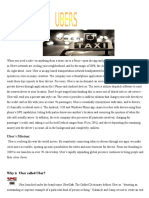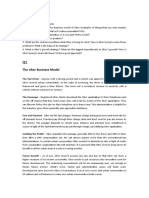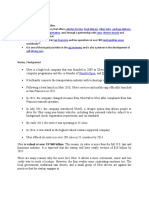Uber Case Study
Uber Case Study
Uploaded by
AnjaliCopyright:
Available Formats
Uber Case Study
Uber Case Study
Uploaded by
AnjaliCopyright
Available Formats
Share this document
Did you find this document useful?
Is this content inappropriate?
Copyright:
Available Formats
Uber Case Study
Uber Case Study
Uploaded by
AnjaliCopyright:
Available Formats
Uber Technologies Inc. (www.uber.
com) is an American international transportation network
company headquartered in San Francisco, California. The company develops, markets and
operates the Uber mobile app, which allows consumers with smartphones to submit a trip
request which is then routed to Uber drivers who use their own cars. Uber now operates in 600
cities in 65 countries, providing more than 10 million rides each day. By the end of 2018, Uber’s
market value was around US$72 billion, with expected revenues for 2018 around US$10billion.
However, since it began operation in 2012,Uber’s net income has been negative.
It is estimated that worldwide there are 75 million ‘loyal’ Uber passengers, who are served by 3
million Uber drivers worldwide, 0.75 million in the US, and2.25 million drivers in the rest of the
world.
Consumers appreciate Uber, and rival services like Lyft in the US, Didi Kuaidi in China and
GrabTaxi in South-East Asia, because they tend to be cheaper than conventional taxis, cleaner
and more reliable. Uber’s freelance drivers typically pay Uber around 20per cent of their fares.
For many of Uber’s freelance drivers, flexible working hours and being spared the formalities of
qualifying as a conventional cabbie area an advantage.
Uber is a case study in how to construct a ‘platform’, a digital service on top of which other
businesses can be built. As it arrives in a city, it launches a vigorous recruiting programme for
drivers, offering them incentives to sign up. Its fares are ‘dynamic’– they undercut conventional
taxis most of the time, but go up when it rains, or when there is some other reason why
demand for rides is high.
This encourages more of its drivers onto the roads when they are most needed. This in turn
means that customers can always get a car quickly, even if it sometimes costs a bit more. This
encourages them to keep using Uber, in turn providing lots of work for its drivers. In recent
years Uber has moved into new fields and diversified its core offering, by introducing peer-to-
peer rides through UberPOP ride sharing through Uber Pool and various levels of luxury options.
Furthermore, Uber has also started funding research into autonomous cars.
Uber’s presence in cities has provoked a reaction among regulators. Taxi drivers have also taken
on the company with protest and violence against Uber drivers
You might also like
- Uber, Operational StrategyDocument22 pagesUber, Operational StrategyNoelraj Kalkuri100% (3)
- The Rideshare Guide: Everything You Need to Know about Driving for Uber, Lyft, and Other Ridesharing CompaniesFrom EverandThe Rideshare Guide: Everything You Need to Know about Driving for Uber, Lyft, and Other Ridesharing CompaniesRating: 3.5 out of 5 stars3.5/5 (3)
- Uber - The Quest For Legitimacy in Digital DisuptionDocument22 pagesUber - The Quest For Legitimacy in Digital Disuptionali sriNo ratings yet
- Uber 2014Document14 pagesUber 2014Tommy Tracx100% (1)
- Ubers Company IntroductionDocument4 pagesUbers Company Introductionsufyan100% (1)
- UBER Driving Change in TransportationDocument14 pagesUBER Driving Change in TransportationAjinkyaNo ratings yet
- Uber FinalDocument8 pagesUber Finalkforkota100% (1)
- Uber:: The New Face of E-Commerce?Document4 pagesUber:: The New Face of E-Commerce?Kuldeep ShrivastavaNo ratings yet
- Assignment No 1 PomDocument5 pagesAssignment No 1 PomAmina IqbalNo ratings yet
- Can Uber Be The Uber of Everything?Document6 pagesCan Uber Be The Uber of Everything?pgkshirsagarNo ratings yet
- Uber in ChinaDocument16 pagesUber in ChinaMochamad Arief RahmanNo ratings yet
- Tutorial UberDocument4 pagesTutorial UberShivakumar BanavathNo ratings yet
- Uber Case PDFDocument2 pagesUber Case PDFShadick SadmanNo ratings yet
- OLA VS UBER: The Battle of Dominance: Dr. Ruchi Shukla, Dr. Ashish Chandra & Ms. Himanshi JainDocument6 pagesOLA VS UBER: The Battle of Dominance: Dr. Ruchi Shukla, Dr. Ashish Chandra & Ms. Himanshi JaincalaghanNo ratings yet
- Gara Case Study Analysis 2017Document14 pagesGara Case Study Analysis 2017vicentahechanova100% (1)
- Uber Mini ProjectDocument8 pagesUber Mini Projectfatima ghaffarNo ratings yet
- March 2009, San Francisco, California, United States: The Uber Business Model in A NutshellDocument7 pagesMarch 2009, San Francisco, California, United States: The Uber Business Model in A Nutshellbakhtawar soniaNo ratings yet
- Uber CaseDocument13 pagesUber CaseMohamed Ahmed AbdelatyNo ratings yet
- Uber: Feeling The Heat From Competitors and Regulators Worldwide Issue/Problem IdentificationDocument3 pagesUber: Feeling The Heat From Competitors and Regulators Worldwide Issue/Problem IdentificationJennyNo ratings yet
- Uber Technologies Inc.: Managing Opportunities and ChallengesDocument12 pagesUber Technologies Inc.: Managing Opportunities and ChallengesAnuj KushwahaNo ratings yet
- UBER Case Study 2015 PDFDocument5 pagesUBER Case Study 2015 PDFPawan KumarNo ratings yet
- Case StudyDocument7 pagesCase StudyRiya PrabhaviNo ratings yet
- DQ5 Uber of EverythingDocument3 pagesDQ5 Uber of EverythingNabilaNo ratings yet
- Uber - Service Promotions ProjectDocument23 pagesUber - Service Promotions ProjectAnshuman Dhanorkar100% (1)
- Ola and UberDocument65 pagesOla and UberRiyaz Ali100% (3)
- Uber PDFDocument11 pagesUber PDFNavajyoti DharNo ratings yet
- Customer Satisfaction Towards Uber Cab (AKSHAY SINGH)Document42 pagesCustomer Satisfaction Towards Uber Cab (AKSHAY SINGH)Lucky SrivastavaNo ratings yet
- Uber Case StudyDocument16 pagesUber Case StudyshaquilleNo ratings yet
- MM AssignmentDocument3 pagesMM AssignmentSyed Irtiza HaiderNo ratings yet
- Exposé Anglais UberDocument3 pagesExposé Anglais Uberlisa rouxNo ratings yet
- Uber - Competing As A Market Leader in The USA Vs Being A Distant Second in ChinaDocument9 pagesUber - Competing As A Market Leader in The USA Vs Being A Distant Second in ChinaTrúc Ngân NguyễnNo ratings yet
- Chapter 1.1Document15 pagesChapter 1.1buixuanan2012004No ratings yet
- BTN 211 Case Study 2Document3 pagesBTN 211 Case Study 2Marcelline WijayaNo ratings yet
- Topic: Consumer Satisfaction Comparison Between Ola/UberDocument10 pagesTopic: Consumer Satisfaction Comparison Between Ola/Ubersagar sadamastulaNo ratings yet
- 7ps Service MarketingDocument5 pages7ps Service MarketingneethuNo ratings yet
- Seminar 1 - UberDocument1 pageSeminar 1 - UberSharbandi RyeNo ratings yet
- Carnegie Mellon Pittsburgh Self-Driving Vehicles Bill PedutoDocument3 pagesCarnegie Mellon Pittsburgh Self-Driving Vehicles Bill PedutoShreya AgrawalNo ratings yet
- UberDocument4 pagesUberGiovanni de los Santos100% (1)
- Uber Mini ProjectDocument8 pagesUber Mini ProjectSunil Dole67% (6)
- Objective of The StudyDocument1 pageObjective of The StudyMahar Kamran AshiqNo ratings yet
- Uber Customer SatisfactionDocument2 pagesUber Customer SatisfactionSakawat hossenNo ratings yet
- Capstone Project OF Issues and Concerns of Stakeholders in The Profitability of Uber and OlaDocument8 pagesCapstone Project OF Issues and Concerns of Stakeholders in The Profitability of Uber and OlaSalini SahaNo ratings yet
- Going App-Less: Accepting Cash Payments On Auto RickshawsDocument6 pagesGoing App-Less: Accepting Cash Payments On Auto RickshawsJaya KamraNo ratings yet
- IntroDocument18 pagesIntroLOLNo ratings yet
- IndividualAssignmentUber YapChoonMing MITDocument6 pagesIndividualAssignmentUber YapChoonMing MITjycm2001100% (1)
- 0 - Cab in Business ModelDocument11 pages0 - Cab in Business ModelSiddharth PandeyNo ratings yet
- Uber CaseDocument2 pagesUber CaseLê Quang KhangNo ratings yet
- UberDocument19 pagesUberJeevesh Sharma33% (3)
- Case 1 - UberDocument1 pageCase 1 - UberadycadizNo ratings yet
- Uber CaseDocument12 pagesUber CaseMathew KanichayNo ratings yet
- Submitted To: Submitted byDocument7 pagesSubmitted To: Submitted bycvikasguptaNo ratings yet
- A Case Study On UberCabDocument9 pagesA Case Study On UberCabSiddhant PandeyNo ratings yet
- Session 5 - UBER, An Empire in The MakingDocument8 pagesSession 5 - UBER, An Empire in The MakingIbraheem SNo ratings yet
- Uber Statistics ReportDocument17 pagesUber Statistics ReportBakayoko VaflalyNo ratings yet
- Uber Strategic Management Final FinalDocument55 pagesUber Strategic Management Final FinalDina Alfawal100% (1)
- A Case Analysis of UberDocument11 pagesA Case Analysis of UberJoshua ChegeNo ratings yet
- UberDocument34 pagesUberSUPREME ADHIKARINo ratings yet
- Customer Satisfaction Towards Uber Cabs: Ali Salim Salman, K. G. ChandrikaDocument15 pagesCustomer Satisfaction Towards Uber Cabs: Ali Salim Salman, K. G. ChandrikaSelamNo ratings yet
- Summary and Analysis of The Upstarts: How Uber, Airbnb, and the Killer Companies of the New Silicon Valley are Changing the World: Based on the Book by Brad StoneFrom EverandSummary and Analysis of The Upstarts: How Uber, Airbnb, and the Killer Companies of the New Silicon Valley are Changing the World: Based on the Book by Brad StoneRating: 5 out of 5 stars5/5 (1)



























































